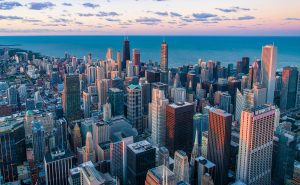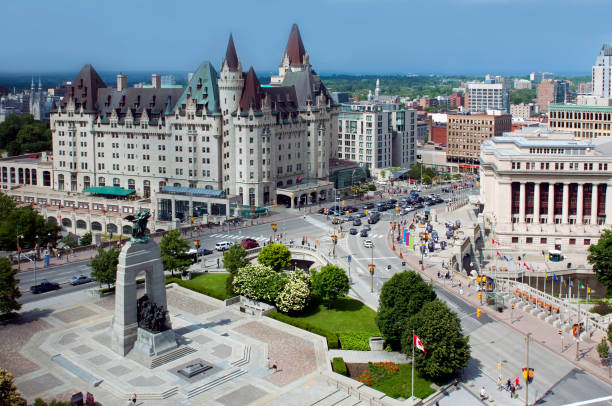
With approximately 23,000 commercial, institutional, and industrial buildings sprawled across the city, it is no surprise that Chicago’s built environment contributes to almost 70% of the city’s greenhouse gas emissions. That is why decarbonizing this sector is essential to meeting Chicago’s goal of reducing citywide greenhouse gas emissions by 62% by 2040. The City has already taken tangible measures to tackling the excessive emissions produced by buildings, such as its long overdue revamp of its building codes in 2019. This update to the city’s building codes included policies such as adopting the International Building Code’s terminology and classification systems, and instituting green building codes. There are also notable programs throughout the city focused on decarbonizing buildings such as Retrofit Chicago, which is working to meet the city’s carbon footprint targets by creating community-based and city-wide retrofit goals that engage all building types.
While overhauling building codes and community initiatives are a good start to reducing greenhouse gas emissions from buildings, it is not enough. As the effects of climate change become increasingly present and the population of Chicago continues to rise, improving the energy efficiency of buildings becomes more and more of a pressing issue.
Why Retrofits are Necessary for Chicago
Performing building retrofits are one of the most effective ways to reduce the greenhouse gas emissions of buildings. This is because retrofits reduce the overall energy demand of a building. Older buildings usually have little insulation, inefficient windows, and leaky seals, resulting in energy loss. Retrofits improve building systems, reducing unnecessary energy use and mitigating loss of heated or cooled air.
Chicago’s weather, underground climate change, and cost savings serve as three primary reasons why building retrofits are of utmost importance for property owners across the city.
Protecting Buildings from the Windy City
Chicago has a continental climate, meaning the city deals with both hot summers and temperatures below freezing in the winter. This dichotomy of temperature makes it necessary for the buildings of the city to be updated to maintain comfortable indoor climates. The building envelope is especially important when considering retrofits for energy efficiency and to protect against severe weather changes. Leaky windows, walls, doors, and roofs not only allow heat to escape and cold to enter, creating uncomfortable indoor environments for tenants, but they can also allow condensation to form in the building envelope, leading to mold growth. Updating insulation within the building’s envelope and implementing vapor and wind barriers are just some ways to minimize heat loss and prevent cold air penetration within a building. Not only do these kinds of retrofits protect tenants from the dramatic Chicago weather, they improve the overall energy efficiency of a building, in turn reducing greenhouse gas emissions.
Chicago is Sinking: The Impact of Underground Climate Change
Venice is not the only city that is sinking. Despite not being surrounded by canals, Chicago is sinking as well do to underground climate change. A study conducted by researchers at Northwestern University found that buildings within Chicago’s Loop are sinking due to excessive heat radiated by downtown structures. Buildings are at the core of this issue as they use large amounts of energy to regulate their temperatures and run appliances, emanating heat downward. Additionally, building materials often absorb more sunlight, increasing the temperature within the city. Energy from this warm air can transfer to beneath the surface. Retrofits are an integral part of the solution to saving Chicago from its sinking fate. Simple retrofits such as installing thermal insulation to walls aid in minimizing the output of heat into the surrounding ground according to Rotta Loria, assistant professor of civil and environmental engineering at Northwestern’s McCormick School of Engineering and leader of the study. As Chicago is largely built on clay, reducing the output of heat into the ground mitigates the contraction of the clay, reducing the effects of underground climate change.
The Cost Savings of Energy Efficient Buildings
One of the more practical reasons for implementing retrofits are the significant energy cost savings. Heating bills in the city have increased in recent winters, exacerbating already high energy costs. Building retrofits can generate energy savings of 5 to 15% with payback periods as little as three years. Specifically, retrofits for the building envelope can help to significantly lower the cost of fuel and power that regulate interior climates. Retrofits are a no brainer when more energy efficient buildings not only equal to less green house gas emissions but also lower costs.
Examples of Retrofits in Chicago’s Buildings
Several buildings in Chicago have already implemented retrofits, with The Science and Engineering Buildings at the University of Illinois Chicago and The Wrigley Building being notable examples. The University of Illinois Chicago was motivated to perform retrofits in order to make progress towards their commitment to Zero Carbon by 2050 and to reduce energy costs. Retrofits performed resulted in a 43% reduction of carbon emissions in 2016 compared to 2011 and increased performance and comfort in 365 laboratory fume hoods. Some of the retrofits performed include weather stripping and caulking around doors and windows, installation of smaller humidifiers to replace the humidification from the district system, and fume hood lighting retrofits.
The Wrigley Building saw a 20% energy reduction from baseline achieved in 2019 as a result of the retrofits performed. The Wrigley Building was motivated to implement retrofits in order to minimize operational costs while maximizing tenant comfort, value and satisfaction. Through the renovation process, the building achieved LEED Silver Core + Shell Certification, ENERGY STAR® Certification, and BOMA 360 Performance Program Certification®. Retrofits implemented include replacing single pane windows with custom high efficiency windows, upgrading boilers, and optimizing existing equipment through thorough maintenance.
It is clear that energy efficiency of the skyscrapers, monuments, and homes that make up the city is necessary to paving a way for a sustainable, climate resilient, and prosperous Chicago. While new building codes and climate initiatives are important steps towards a net zero Chicago, retrofits are the missing puzzle piece towards tackling one of Chicago’s biggest greenhouse gas emitters.


